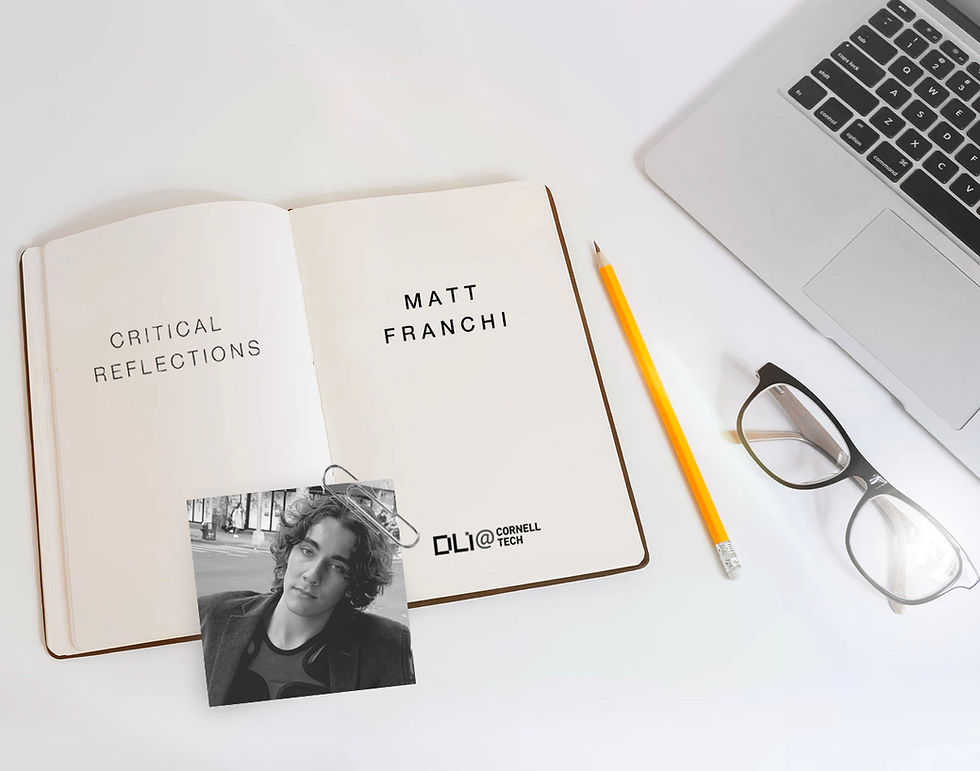On News, Narrative, and Thinking About Technology
- Digital Life Initiative

- Feb 12, 2023
- 3 min read

By Corin Faife (Cornell Tech)
Introducing a new guest editor for Critical Reflections.
Hello, Critical Reflections readers! Please allow me to introduce myself.
I've been covering technology news for around a decade now, and over that time I’ve had the chance to write about many major topics in the field: from blockchain to bots, streaming to surveillance, online activism to algorithmic discrimination. I was the first reporter to publish stories using data from The Markup’s pioneering Citizen Browser project, digging into Facebook’s newsfeed algorithm, and investigating whether the claims the company made about it were supported by the evidence. After that, I anchored cybersecurity coverage at The Verge, writing about all aspects of hacking, monitoring, and defending computer systems.
I’ve had the good fortune to work with some leading publications over the years, but over the course of that work, I also started to get a sense that something was missing. At times, I have suspected that technology reporters are partly to blame for failing to give the general public a solid framework for thinking about technology.
As journalists, we're good at chronicling the small things: the daily incremental improvements in speed and size, the updates and upgrades that constitute the steady march of progress. We can usually capture and explain the big things too: the breakout successes like ChatGPT, or spectacular failures like the collapse of FTX or Theranos. While we succeed at telling our audience how certain kinds of technology function, or what new developments lie in wait around the corner, where we fall short is in explaining how to think about what technology is and why.
Ultimately, theories of technology are largely absent from tech reporting. There’s certainly an exchange of ideas between academic researchers and journalists, but it’s rare for news coverage to make the link between concrete realities and abstract frameworks, or present normative claims about how systems should work. (A small number of institutions bridge the gap between theory, research, on-the-ground investigation and public communication – Data & Society being one good example – but they are the exception rather than the rule.) As a result, though the experience of rapid technological change is a quintessential feature of life in our times, it’s often perceived as an abstract, almost elemental force that sweeps us along, instead of as an accrual of choices and decisions made by distinct entities, an inseparable blend of the social and the technical.
So as Peggy J. Koenig Civic Innovation Fellow here at Cornell Tech, I'll be using my time to think about how us journalists can better communicate some of these things, as well as how news media can adapt to the rapidly evolving technology landscape. And as a guest editor of Critical Reflections, I'm also here to prod some of the faculty and other research fellows — gently of course — to do the same thing: communicate to a non-academic audience some general approaches for thinking about technology, as well as give theoretical insights into ongoing tech news stories.
All of that is to say that the new editorial approach will probably involve some experiments in style and presentation, and a measure of throwing things at the wall to see what sticks. You can also expect to see more direct engagement with news, and an effort to join the dots between trending technology topics and work being done at Cornell Tech.
The news cycle moves quickly, more so than ever in the age of social media, and contributing to media discourse as it unfolds can sometimes feel like trying to board a moving train. But by harnessing the peaks and troughs in attention for certain topics, and tailoring our messaging strategically, we can inject a more meaningful understanding of technology into the public sphere. It might well be a gradual process, but like adjusting the direction of any body in motion, small interventions translate to bigger shifts over time.
Corin Faife
Digital Life Initiative
Cornell Tech
Cornell Tech | 2023




